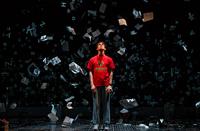The One Book, One Philadelphia 2017 featured selection, The Curious Incident of the Dog in the Night-Time, is often described as a book about a unique teen on a quest. When trying to describe that uniqueness, many readers and reviewers alike have most closely identified narrator Christopher Boone’s behaviors and mental processes with Autism Spectrum Disorder.
What is Autism Spectrum Disorder (ASD)?
According to Autism Speaks, it is a group of complex disorders of brain development characterized by difficulties in social interaction and communication. Symptoms and their severity vary widely, which is why diagnoses are made on a spectrum. Christopher, the Curious Incident’s protagonist, is considered on the high-functioning end of the spectrum, with relatively mild challenges—a condition once called Asperger’s Syndrome.
What are Christopher’s symptoms of ASD?
A common difficulty of those with ASD is interpreting what others are thinking or feeling. They also often have difficulty seeing things from another person's perspective. Near the beginning of the novel, Christopher describes how one of his teachers would draw facial expressions for him, to help him identify what others are feeling. He comments, "And now if I don’t know what someone is saying, I ask them what they mean or I walk away" (3). Not only has he learned to recognize elements of interaction he doesn’t understand, but he has also learned what to do in those situations.
Christopher speaks very literally, and in the first few chapters of the book he talks about the process of writing the book. "This will not be a funny book," he says. "I cannot tell jokes because I do not understand them" (8). Here he is describing another trait often found in those with ASD—an inability to understand body language, tone of voice, and expressions that aren’t meant to be taken literally. For the same reason, he dislikes idioms and metaphors, because he doesn’t think they make sense. When he tries to picture "an apple in someone’s eye," he gets confused—"because imagining an apple in someone’s eye doesn’t have anything to do with liking someone a lot" (15). This issue is one shared by English language learners, who may have the language skills to decode literal meaning but do not know the connotations we assign certain turns of phrase in the United States.
Christopher seems to be highly aware of how his own brain works. In describing why he is telling this particular story, about a dog being killed, he says it is "… because it happened to me and I find it hard to imagine things which did not happen to me" (5).
In the very first scene, readers also see Christopher react jarringly in response to a screaming neighbor: "I put my hands over my ears and closed my eyes and rolled forward till I was hunched up with my forehead pressed onto the grass" (4). As with those with ASD, Christopher often has difficulty regulating his emotions. His outbursts are often triggered when he is overwhelmed: "I make this [groaning] noise when there is too much information coming into my head from the outside world" (7).
Yet Christopher is also highly intelligent, as are many with ASD. He is particularly talented at math and he has a deep wealth of factual knowledge. In the beginning of Chapter 2, he affirms, "I know all the countries of the world and their capital cities and every prime number up to 7,057" (2).
Having intense preoccupations and focusing on order are traits are also linked to ASD. These are often also the very traits that can make those with ASD highly successful.
Is this meant to be a book about ASD?
For all these similarities between Christopher’s behavior and characteristics of ASD, author Mark Haddon does not consider this book to be one about Autism or Asperger’s. "It's a novel whose central character describes himself as 'a mathematician with some behavioural difficulties'," Haddon explains. "If anything it’s a novel about difference, about being an outsider, about seeing the world in a surprising and revealing way."
Whether readers choose to ascribe the ASD label to Christopher, the novel, as Haddon attests, is a wonderful tool for recognizing—and celebrating—different ways of thinking.
**Check back every #OneBookWednesday during the Reading Period for some more One Book food-for-thought!**
Have a question for Free Library staff? Please submit it to our Ask a Librarian page and receive a response within two business days.

